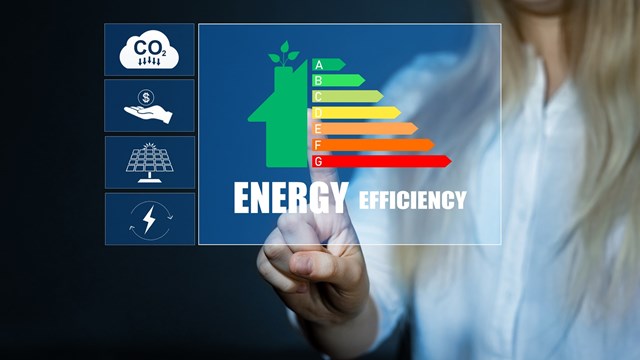
There is little doubt that what started as a green building trend, with all of its energy efficiency measures and renewable energy options, has evolved into a rational way to add value to your property. In fact a recent Roper survey showed that "two-thirds of Americans are willing to pay a premium for homes that have solar power systems installed when told that solar homes have a proven higher resale value."
The reasoning is not complicated—having a lower monthly utility bill will free up capital and/or lower expenses. Spending today's dollars for energy efficiency upgrades and on-site renewable energy systems is also an effective way to "hedge" against escalating energy costs. Expected increases in energy costs are especially irksome to landlords and HOA boards who are responsible for lighting, heating and cooling common areas, but have little recourse for conservation or rate increases. Although it is clear that the status quo is not acceptable, from financial or environmental perspectives, implementing the changes costs money. Unfortunately not everyone interested in going green has the capital necessary to make the transition.
The challenge is to develop new financial models to meet the demand by providing funding for rapidly evolving energy efficiency measures and renewable energy technologies. Congress has (perhaps inadvertently) helped to address this issue by passing two bills after a lengthy Saturday session on the last day before the Congressional summer recess. Both bills, HR 2776 and HR 3221, are loaded with provisions that will lead to additional funding for the development and implementation of green energy solutions. HR 2776, for example, removes key limitations to long-term funding by:
• Providing an eight-year extension of the existing 30 percent Investment Tax Credit for businesses under Section 48 of the tax code
• Providing the ability for corporate and personal filers to claim the Investment Tax Credit against the Alternative Minimum Tax (AMT)
• Removing the prohibition barring utilities from using the Section 48 Investment Tax Credit.
• Providing up to $2.4 billion in bonding authority for the issuance of Clean Renewable Energy Bonds
Also of note, an Amendment in HR 3221 establishes a Renewable Electricity Standard (RES) which requires electric suppliers, other than governmental entities and rural electric cooperatives, to provide 15 percent of their electricity using renewable energy resources by the year 2020.
An off-shoot of this legislation is the tremendous incentive for investors who will be prepared to provide capital for green building improvements. Investment funds, corporations and Limited Liability Corporations (LLCs) can take advantage of the 30 percent Investment Tax Credit and Modified Accelerated Cost Recovery System (accelerated depreciation) to work down their tax liabilities. Utilities will look to partner with their customers to install solar and renewable energy systems at appropriate properties. The financial model that is evolving is structured and described as a Power Purchase Agreement or PPA. These multi-year agreements facilitate the installation of energy saving systems without any capital expense. A PPA will cover all costs including material, labor, monitoring and maintenance. A property owner simply serves as a host site and purchases the power produced by the system. Capital will become more accessible for co-ops, condos and commercial property owners as they begin the transition to green alternatives.
Many of the green products on the market today have been improved—in both efficiency and aesthetics. Solar thermal (hot water) systems are effective throughout the year. Solar hybrid lighting systems will provide light both day and night, and solar electric (photovoltaic) systems are available in models described as Building Integrated. These new products were designed to "integrate" with traditional building materials to minimize their visibility, and in some cases they serve as both structural and energy producing components. Building Integrated products include solar roofing tiles, solar atriums and solar carports.
A well-designed solar power system can be installed on any surface area that gets plenty of sun. The most common example is a building's roof, which is viewed by the solar industry as an under-utilized asset. Solar carports can also make better use of parking lot space by producing electricity—while also providing shade and shelter from the elements. Creative design and advanced engineering gives property owners the ability to leverage unused space to produce clean, renewable energy.
There are many valid reasons for considering renewable energy to replace some, or all, of the power presently being purchased from the utility. The most obvious is the savings and "hedging" effect. Other popular reasons include carbon offsets—producing clean, renewable power can prevent the release of CO2 and other harmful greenhouse gasses. A small 10-kilowatt solar power system can prevent the release of more than 13,000 lbs. of CO2—in the first year. This is equivalent to the emissions produced by driving a car 16,500 miles.
On-site renewable systems can also increase the reliability of the electric grid. Solar power systems produce peak power during the same hours that the grid is most strained by demand. Utilities recognize the value of distributed power generation because it produces power when it is needed and where it is needed, without the need for infrastructure enhancements. In fact many utilities support distributed renewable power by providing rebates and offering net-metering. By entering into a net-metering agreement you can send any excess power you produce back to the utility. Your meter will run backwards and your account will be credited at retail rates for every kilowatt hour you send back to the grid.
Producing on-site renewable power will also help to reduce our nation's dependency on foreign oil. According to Dr. Franz Trieb from the Institute for Technical Thermodynamics, "Every year, each square kilometer of desert receives solar energy equivalent to 1.5 million barrels of oil."
It is no surprise that within a year or two a number of automobile manufacturers will be introducing both all electric and plug-in hybrid vehicles. These vehicles will be plugged in to a typical household outlet and charged during the night—in some cases using the excess kilowatt hours that were sent to the grid by your solar power system during the day.
The case for green building has never been stronger and when approached logically the decision to migrate to green technologies should be an easy one. The first step is to create a plan and identify priorities. Develop consensus by including all of the relevant committees, e.g., the grounds/facilities, environmental committees, etc. Coordinate research on the grants and rebates that may be available for your green projects. Provide an educational forum to communicate your goals and timelines. Once you have outlined the scope and costs of the project you can look at funding options. Knowing that you can possibly execute your plan without any capital expenditure should make it easier to sell internally.
Going green is now a much easier proposition but you have to take the first step. Call on the experts; many renewable energy companies have already worked with developers, HOAs and condo associations and they can provide valuable input and guidance.
Mike Donnelly is the director of business development with Wall, New Jersey-based Premier Power Renewable Energy, Inc., a licensed and bonded solar electric contractor that operates in California, Nevada, New York, New Jersey and Spain.






Leave a Comment